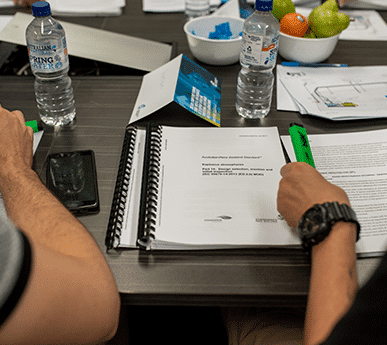The 9-Minute Rule for Roar Solutions
The 9-Minute Rule for Roar Solutions
Blog Article
An Unbiased View of Roar Solutions
Table of ContentsThe Ultimate Guide To Roar SolutionsThe 45-Second Trick For Roar SolutionsSome Ideas on Roar Solutions You Should Know
In such an ambience a fire or explosion is feasible when three fundamental problems are satisfied. This is frequently referred to as the "unsafe area" or "combustion" triangle. In order to shield installations from a potential surge an approach of analysing and classifying a possibly unsafe area is required. The objective of this is to make sure the correct choice and installation of equipment to eventually stop a surge and to make certain safety of life.
(https://pinshape.com/users/7197164-roarsolutions#prints-tab-open)
No equipment needs to be mounted where the surface area temperature of the devices is above the ignition temperature level of the provided risk. Below are some typical dirt unsafe and their minimal ignition temperature level. Coal Dirt 380C 225C Polythene 420C (melts) Methyl Cellulose 420C 320C Starch 460C 435C Flour 490C 340C Sugar 490C 460C Grain Dust 510C 300C Phenolic Resin 530C > 450C Aluminium 590C > 450C PVC 700C > 450C Residue 810C 570C The chance of the risk existing in a focus high adequate to cause an ignition will differ from place to place.
In order to categorize this threat an installation is divided into areas of threat relying on the amount of time the hazardous exists. These areas are described as Zones. For gases and vapours and dirts and fibres there are three areas. Area 0 Zone 20 A harmful environment is extremely likely to be present and may be existing for extended periods of time (> 1000 hours per year) and even continuously Zone 1 Zone 21 A hazardous atmosphere is possible yet unlikely to be existing for long periods of time (> 10 450 C [842 F] A category of T6 implies the minimal ignition temperature is > 85 C [185 F] Unsafe area electric equipment maybe made for use in higher ambient temperatures. This would certainly suggested on the rating plate e.g. EExe II C T3 Ta + 60C( This suggests at 60C ambient T3 will certainly not be surpassed) T1 T1, T2, T3, T4, T5, T6 T2 T2, T3, T4, T5, T6 T3 T3, T4, T5, T6 T4 T4, T5, T6 T5 T5, T6 T6 T6 A T Course score of T1 implies the maximum surface temperature produced by the tool at 40 C is 450 C. Thinking the connected T Class and Temperature level score for the devices are ideal for the location, you can always utilize a tool with an extra stringent Department ranking than needed for the area. There isn't a clear solution to this concern however. It actually does depend on the type of tools and what repair services need to be executed. Devices with certain test procedures that can not be done in the area in order to achieve/maintain 3rd celebration ranking. Must come back to the factory if it is before the devices's solution. Area Repair Work By Authorised Employee: Complex screening might not be required nonetheless particular treatments may need to be complied with in order for the tools to maintain its 3rd party rating. Authorised workers need to be utilized to execute the work properly Repair should be a like for like substitute. New element should be taken into consideration as a straight substitute calling for no special screening of the devices after the repair service is complete. Each piece of tools with a harmful ranking must be examined separately. These are described at a high level below, visit this site right here but also for more in-depth information, please refer directly to the standards.
Examine This Report on Roar Solutions
The devices register is a comprehensive data source of tools records that includes a minimum set of areas to recognize each thing's place, technical specifications, Ex classification, age, and ecological information. The ratio of Comprehensive to Close evaluations will be determined by the Tools Danger, which is examined based on ignition risk (the probability of a resource of ignition versus the chance of a flammable atmosphere )and the unsafe location classification
( Zone 0, 1, or 2). Carrying out a durable Risk-Based Inspection( RBI )approach is crucial for making certain conformity and safety in managing Electric Equipment in Hazardous Locations( EEHA).
The Roar Solutions Diaries

In terms of eruptive threat, an unsafe location is an environment in which an explosive atmosphere is present (or might be anticipated to be present) in amounts that call for special precautions for the construction, installation and use devices. eeha. In this short article we discover the difficulties faced in the office, the threat control steps, and the called for proficiencies to function safely
These compounds can, in particular conditions, form eruptive atmospheres and these can have major and heartbreaking repercussions. Many of us are familiar with the fire triangle remove any one of the three aspects and the fire can not take place, but what does this mean in the context of hazardous areas?
In a lot of instances, we can do little regarding the degrees of oxygen in the air, but we can have substantial influence on sources of ignition, as an example electrical devices. Dangerous areas are recorded on the dangerous area classification drawing and are recognized on-site by the triangular "EX-SPOUSE" sign. Here, among other essential information, zones are divided right into three types depending upon the risk, the possibility and duration that an explosive environment will exist; Zone 0 or 20 is deemed the most harmful and Zone 2 or 22 is deemed the least.
Report this page